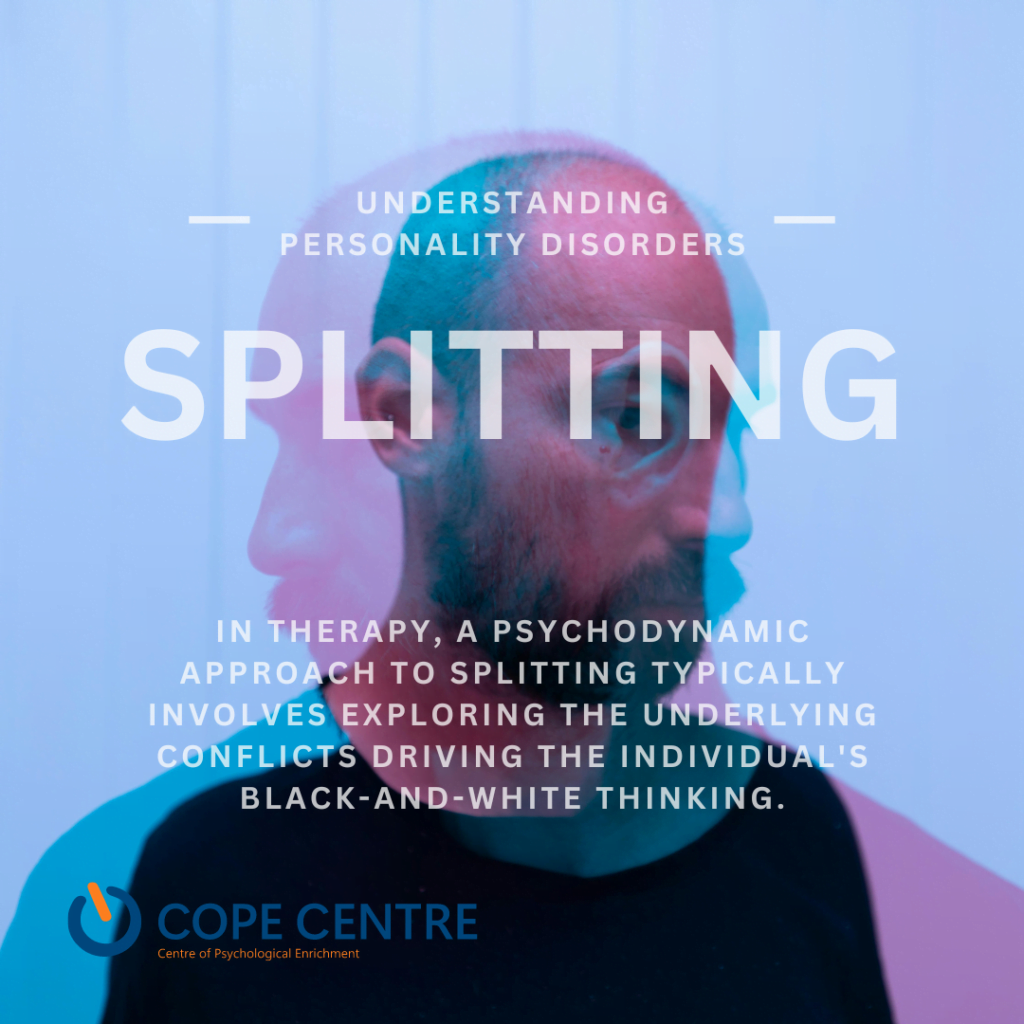Defense mechanism
Splitting is a defense mechanism observed in some individuals with borderline personality disorder. Splitting is a psychological defense mechanism that involves a person’s tendency to perceive people, situations, or experiences as all good or all bad. From a psychodynamic perspective, splitting is viewed as managing intense and often conflicting emotions that arise from unresolved conflicts within the individual. Individuals may adopt a coping strategy in response to overwhelming emotional experiences, particularly early in life.


According to Sigmund Freud, the founder of psychoanalysis, splitting is a primitive defense mechanism present in infancy and childhood. Infants and young children have limited cognitive and emotional capacities and experience the world in a very binary way. This means they see things as either good or bad, with no shades of grey in between.
When someone experiences overwhelming emotions or stress, splitting can offer a temporary respite by creating a clear and straightforward dichotomy between good and bad. However, splitting remains a dominant defense mechanism for some individuals into adulthood. This can happen for several reasons, including early trauma, neglect, or a lack of consistent caregiving.
How does Splitting Develop?
From a psychodynamic perspective, splitting is thought to develop in response to early experiences of ambivalence, conflict, and inconsistency in childhood relationships. For example, suppose a child grows up with a parent who is sometimes loving and supportive and other times distant and critical. In that case, the child may develop a tendency to split the parent into “good” and “bad” parts in order to make sense of the conflicting messages they receive.
Splitting can also defend against feelings of vulnerability and helplessness by creating a sense of control and certainty in what seems like a chaotic and unpredictable world. Splitting helps to manage this inner conflict by creating a clear separation between different parts of the self. For example, a person who splits may view themselves as either completely good or completely bad, with no overlap between the two. They may view others in a similar way, as either all good or all bad, depending on their current emotional state.
While splitting can be a helpful coping mechanism in the short term, it can also lead to problems in relationships and emotional regulation. By dividing experiences and people into rigid categories, individuals may struggle to form healthy relationships or engage in constructive conflict resolution. They may also experience difficulties regulating their emotions, as they lack the ability to tolerate and integrate a wide range of emotional experiences.
This black-and-white thinking can be problematic, as it can lead to difficulty in forming and maintaining relationships, as well as issues with self-esteem and self-worth. It can also make it challenging to regulate emotions effectively, as the individual may struggle to tolerate any emotions that do not fit into their established framework of good or bad.


Splitting and mental health disorders
- Splitting is a psychological defense mechanism that is commonly observed in personality disorders, particularly borderline personality disorder (BPD). A borderline personality disorder is a mental health disorder characterized by extreme mood swings, unstable relationships, and a distorted self-image. Individuals with BPD often have difficulty regulating their emotions and may engage in impulsive or self-destructive behaviours as a result leading to intense and unstable emotions and impulsive and self-destructive behaviours.
- This type of black-and-white thinking can also extend to the individual’s own self-image, with periods of extreme self-loathing or self-idealization. For example, an individual with BPD may idolize a romantic partner one moment, viewing them as perfect and idealizing them to an extreme degree. However, if that partner disappoints or upsets them, the individual may suddenly view them as entirely bad or evil, demonizing them and cutting them out of their life.
- In the context of an eating disorder, splitting can manifest in a number of ways. For example, someone with anorexia may see themselves as either “perfect” when they adhere strictly to their restrictive eating habits or “worthless” when eating anything outside their plan. Similarly, someone with bulimia may view themselves as either “in control” when purging or “out of control” when not.
- Splitting can also affect how a person with an eating disorder views others. They may see their loved ones as either entirely supportive or completely unsupportive, depending on whether or not they approve of their eating behaviours. This can lead to strained relationships and difficulty in seeking help.
So how do psychologists treat splitting?


In therapy, a psychodynamic approach to splitting typically involves exploring the underlying conflicts driving the individual’s black-and-white thinking. This may include exploring past experiences or trauma and identifying patterns of behaviour that reinforce the splitting. The therapist may also work with the individual to develop more adaptive coping strategies for greater emotional regulation and a more nuanced view of the self and others.
Treatment for trauma can be challenging, especially when the traumatic experience occurred during childhood and involves our caregivers. The younger we are when we experience trauma, the stronger our defenses can be, making it difficult to remember the experience. Additionally, the negative effects of trauma can be more severe when it occurs at a young age, which can impact how people respond to treatment.
Childhood memories are not typically stored in the same way as adult memories. These memories are often kept in a separate part of the brain to where conscious memories are stored (the amygdala) and may not be easily accessed through conscious recall. This means that individuals with traumatic memories from very early childhood may require deeper work with their therapist to integrate these experiences and release patterns established before the amygdala was fully formed in the brain.
Therapy for childhood trauma often involves a focus on integrating aspects of the self that have become “stuck” in traumatic patterns. This process can be challenging and requires a strong therapeutic relationship and a willingness to work deeply with the therapist.
Overall, splitting is a common defense mechanism that can offer temporary relief from overwhelming emotions or stress. However, it can also be a source of significant distress and interfere with relationships and emotional well-being. A psychodynamic approach to splitting involves exploring the underlying conflicts and developing more adaptive coping strategies to promote greater emotional regulation and a more nuanced understanding of the self and others. With commitment and patience, it is possible to heal from childhood trauma and move towards a healthier, more fulfilling life.
Refs:
Blass, R. B. (2015). Conceptualizing splitting: On the different meanings of splitting and their implications for the understanding of the person and the analytic process. The International Journal of Psychoanalysis, 96(1), 123-139.
Granieri, A., & Schimmenti, A. (2014). Mind–body splitting and eating disorders: a psychoanalytic perspective. Psychoanalytic Psychotherapy, 28(1), 52-70.
Savvopoulos, S., Manolopoulos, S., & Beratis, S. (2011). Repression and splitting in the psychoanalytic process. The International Journal of Psychoanalysis, 92(1), 75-96.
Weiss, H. (2015). Three papers on splitting: A brief introduction. The International Journal of Psychoanalysis, 96(1), 119-122.


